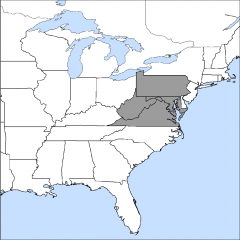Rich Floodplain Forest (Piedmont-Central Appalachian)
Learn More
Where to Explore It
In the Rich Floodplain Forest, flood-deposited sediment creates fertile soil and supports lush vegetation, including American sycamore, box-elder, pawpaw, and Virginia bluebells. (There is more than one type of Rich Floodplain Forest; this one is found in the Piedmont and Central Appalachians.)
The Rich Floodplain Forest is found in the Piedmont and Central Appalachians on the upper terraces of floodplains along large rivers, and main floodplains of medium-sized rivers.
The range map shows the states in which this natural community has been documented.
More About This Natural Community
The Rich Floodplain Forest can have a lush look, especially in the spring, when beautiful wildflowers bloom—look for Virginia bluebells, squirrel-corn, Virginia springbeauty, Canadian waterleaf, and wild blue phlox among others. In the understory, box-elder, pawpaw, and northern spicebush grow densely. Trees, some quite tall, include American sycamore, American elm, bitternut hickory, black walnut, and common hackberry. Vines such as Virginia creeper, eastern poison-ivy, and frost grape are common.
The diverse array of plants is a result of rich soil. The soil is periodically enriched when floods deposit sediment full of minerals and nutrients from upstream.
For a more in-depth look at this community, click on a link under “Where to Explore It.”
Look for It in These National Parks
- Antietam National Battlefield
- Appalachian Trail (Central Appalachians)
- Chesapeake and Ohio Canal National Historical Park
- Eisenhower National Historic Site
- Friendship Hill National Historic Site
- George Washington Memorial Parkway
- Gettysburg National Military Park
- Harpers Ferry National Historical Park
- Manassas National Battlefield Park
- Monocacy National Battlefield
- National Capital Parks – East
Conservation Status
How vulnerable is a natural community? Is it at risk of elimination? Learn about conservation status.
Classification
Official names reduce confusion by providing a common language for talking about natural communities. Why so many names?



